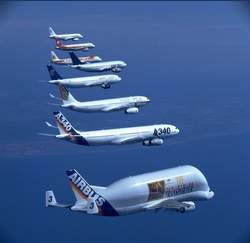Wed, Jun 18, 2003
 3D Systems Corp. announced just yesterday that
Airbus in the United Kingdom purchased an SLA® 7000 system to
produce components for wind tunnel testing at its operations in
Filton, Bristol. The purchase of an SLA 7000 system will be used to
create larger models with tighter tolerances and high quality
surface finish in the wind tunnel.
3D Systems Corp. announced just yesterday that
Airbus in the United Kingdom purchased an SLA® 7000 system to
produce components for wind tunnel testing at its operations in
Filton, Bristol. The purchase of an SLA 7000 system will be used to
create larger models with tighter tolerances and high quality
surface finish in the wind tunnel.
"My background for the last 5 years has been on the test side
where we are always under pressure to meet deadlines," said Martin
Aston wind tunnel domain manager for Airbus in Filton. "We were
already using 3D Systems technology through a third party service
bureau and were aware of some of the advantages of
stereolithography. If we are able to build models more quickly we
can enter the design cycle later, which gives the aerodynamicist
more time to think before committing to a test. We realized over a
year ago, rather than outsourcing our prototyping and model
production, that we needed to invest in new technology of our own
if we were going to improve our cycle times without lowering our
standards."
 "We are currently using the SLA 7000 system for
our Flight Physics which encompasses the aerodynamic groups who
submit new geometries for testing in the tunnel. Typical components
include leading edge and trailing edge configurations, flap tracks,
pylons and nacelles. Having our own SLA system on-site allows us to
react more quickly and more cost effectively to our bottom line,"
continued Aston. "We now try designs we never would have done
before because we have the technology on-site. Effectively we can
think of an idea, put it on the system to build overnight or over a
weekend and test it the next day. If the design doesn't work we
just repeat the process. To do that through a service bureau would
be almost impossible as the typical turnaround time is four
days."
"We are currently using the SLA 7000 system for
our Flight Physics which encompasses the aerodynamic groups who
submit new geometries for testing in the tunnel. Typical components
include leading edge and trailing edge configurations, flap tracks,
pylons and nacelles. Having our own SLA system on-site allows us to
react more quickly and more cost effectively to our bottom line,"
continued Aston. "We now try designs we never would have done
before because we have the technology on-site. Effectively we can
think of an idea, put it on the system to build overnight or over a
weekend and test it the next day. If the design doesn't work we
just repeat the process. To do that through a service bureau would
be almost impossible as the typical turnaround time is four
days."
Airbus has started experimenting with models that they would
never have attempted or thought possible previously. Producing
plastic models using the SLA system enables Airbus to cater for all
of the shapes and curves of aircraft components. Geometric form and
dimensional stability has been dramatically improved, which means
the test data is more accurate. By having the technology on-site a
deeper understanding of the process has been invaluable. This
knowledge allows the project coordinator to define and control
specific attributes of the geometry by understanding the
technology. They can then communicate these constraints with the
operator and part quality can be maintained.
"We no longer have the delay of waiting for returns if we need
to build a new iteration, we simply re-run it on the SLA system,"
stated Aston.
More News
Light Gun A handheld directional light signaling device which emits a brilliant narrow beam of white, green, or red light as selected by the tower controller. The color and type of>[...]
“We have performed extensive ground testing by comparing warm up times, full power tethered pulls, and overall temperatures in 100 degree environments against other aircraft >[...]
While Taxiing To Parking The Right Landing Gear Leg Collapsed, Resulting In Substantial Damage Analysis: The pilot made a normal approach with full flaps and landed on the runway. >[...]
From 2014 (YouTube Edition): Exotic Rebuild Reveals Aerial Work Of Art During EAA AirVenture 2014, ANN's Michael Maya Charles took the time to get a history lesson about a great ai>[...]
Also: Project Talon, McFarlane Acquisition, Sky-Tec Service, JPL Earth Helo Tests Bombardier has earned a round of applause from the business aviation community, celebrating the fo>[...]
 ANN's Daily Aero-Term (12.13.25): Light Gun
ANN's Daily Aero-Term (12.13.25): Light Gun Aero-News: Quote of the Day (12.13.25)
Aero-News: Quote of the Day (12.13.25) NTSB Final Report: Gippsland GA-8
NTSB Final Report: Gippsland GA-8 Classic Aero-TV: Historically Unique -- Marlin Horst's Exquisite Fairchild 71
Classic Aero-TV: Historically Unique -- Marlin Horst's Exquisite Fairchild 71 Airborne 12.12.25: Global 8000, Korea Pilot Honors, AV-30 Update
Airborne 12.12.25: Global 8000, Korea Pilot Honors, AV-30 Update




